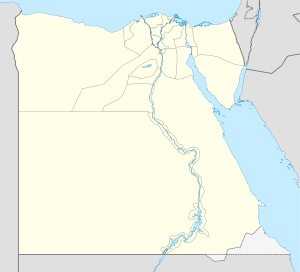- Tahpanhes
-
Coordinates: 30°51′38″N 32°10′17″E / 30.86056°N 32.17139°E
Tahpanhes Location in Egypt Coordinates: 30°51′38″N 32°10′17″E / 30.86056°N 32.17139°E Country  Egypt
EgyptTime zone EST (UTC+2) – Summer (DST) +3 (UTC) Tahpanhes (also transliterated Tahapanes or Tehaphnehes; known by the Ancient Greeks as Daphnae, now Tell Defenneh) was a city in Ancient Egypt. It was located on Lake Manzala on the Tanitic branch of the Nile, about 16 miles from Pelusium. The site is now situated on the Suez Canal.
History
According to the Hebrew Bible, the Jews from Jerusalem fled to this place after the death of Gedaliah and settled there for a time (Jeremiah 2:16; 43:7,8,9; 44:1; 46:14; Ezekiel 30:18).
A platform of brick-work, which there is every reason to believe was the pavement at the entry of Pharaoh's palace, has been discovered at this place. "Here," says the discoverer, William Flinders Petrie, "the ceremony described by Jeremiah 43:8-10; "brick-kiln", i.e., pavement of brick] took place before the chiefs of the fugitives assembled on the platform, and here Nebuchadnezzar II spread his royal pavilion".
King Psammetichus established a garrison of foreign mercenaries at Daphnae, mostly Carians and Ionian Greeks (Herodotus ii. 154). After the destruction of Jerusalem by Nebuchadrezzar II in 588 BC, the Jewish fugitives, of whom Jeremiah was one, came to Tahpanhes.
When Naucratis was given the monopoly of Greek traffic by Amasis II, the Greeks were all removed from Daphnae and its prosperity never returned; in Herodotus's time the deserted remains of the docks and buildings were visible.
The site was discovered by Sir William Matthew Flinders Petrie in 1886; it was then known by natives as the "Castle of the Jew's Daughter".[1] There is a massive fort and enclosure; the chief discovery was a large number of fragments of pottery, which are of great importance for the chronology of vase-painting, since they must belong to the time between Psammetichus and Amasis, i.e. the end of the 7th or the beginning of the 6th century BC. They show the characteristics of Ionian art, but their shapes and other details testify to their local manufacture.
Notes
References
- http://education.yahoo.com/reference/encyclopedia/entry/Tahpanhe
- WMF Petrie, "Tanis II., Nebesheh, and Defenneh" (the Memoir of the Egypt Exploration Fund, 1888).
 This article incorporates text from a publication now in the public domain: Chisholm, Hugh, ed (1911). Encyclopædia Britannica (11th ed.). Cambridge University Press.
This article incorporates text from a publication now in the public domain: Chisholm, Hugh, ed (1911). Encyclopædia Britannica (11th ed.). Cambridge University Press.- This article incorporates text from Easton's Bible Dictionary (1897), a publication now in the public domain.
Categories:- Hebrew Bible cities
- Ancient Greek cities
- Ancient Greek sites in Egypt
- Populated places in Egypt
- Former populated places in Egypt
Wikimedia Foundation. 2010.

